Kids’ meals are one of the great paradoxes. Young brains and bodies are rocketing toward their potential and need the very best fuel — namely, whole foods rich in nutrients. But the highly processed fare that’s served to children in many school cafeterias and marketed to them via television and grocery-store displays is far from that ideal.
Parents often struggle, though, to come up with creative, nutritious lunches that their kids will eat.
To help us revamp three typical lunches, we assembled a dream team of functional-medicine nutritionists: Kathie Swift, MS, RDN; Maggie Ward, MS, RDN, LDN; and Adriane Angarano, MS, CN.
Their most essential advice? Drop the notion that children ought to be eating foods especially designed for them. “The differentiation between children’s and adults’ food has to end,” says Kathie Swift. “It’s food. We should all be eating the same thing.”
Swift grew up in an Italian family that cooked and ate together. She and our other nutritionists emphasize that including children in the tasks that underpin the family’s eating (such as grocery shopping, cooking, and even plucking cherry tomatoes from the garden) teaches them to better appreciate the food they eat.
Yes, these lunches do take time and effort, but they give kids the energy and focus they need to make the best of their school day. Consider assembling or prepping components over the weekend, or making them for dinner and sending leftovers for lunch the next day.
Kathie Swift, MS, RDN
We asked Kathie Swift, MS, RDN, for her take on a fairly typical school lunch of a hot dog, applesauce, granola bar, and a soda. “That meal has an extraordinarily high PW ratio,” she says, referring to the ratio of processed to whole foods. It’s also high in sugar, explains Swift, and low in the fermentable fiber that feeds the good bacteria that help our bodies function properly. Swift, education director for Food As Medicine at Washington, D.C.’s Center for Mind-Body Medicine, says these bacteria — part of our microbiota — are critical to our health and well-being. Her recommended alternative is tempeh kebabs with vegetables, apple slices, and water.
BEFORE: Lunch #1

Hot dogs:
Most commercial wieners are loaded with unhealthy additives, including preservatives, artificial flavors, and artificial colors. They are also packed with sodium, and while our bodies need salt, processed foods add too much to our diets. Besides, why not expand your children’s palate beyond hot dogs? “If you can get a kid to try a new food enough times, their taste buds will generally come on board,” says Swift, referencing research from the Monell Chemical Senses Center.
Granola bar:
The word “granola” tricks us into thinking these bars are a healthy treat, but most of them contain way too much sugar, and some contain trans fats. Swift says that healthy food is more likely to come from our refrigerators and freezers than our pantries, which is where highly processed “shelf-stable” foods stay “fresh” forever.
Applesauce and soda:
This duo represents a tsunami of sugar — which is why a child eating this lunch is likely to run out of steam or even exhibit behavioral problems by midafternoon, says Swift. “Not to mention that it sets them up to crave more sugar-laden, processed foods [later in the day].”
AFTER: Lunch #1
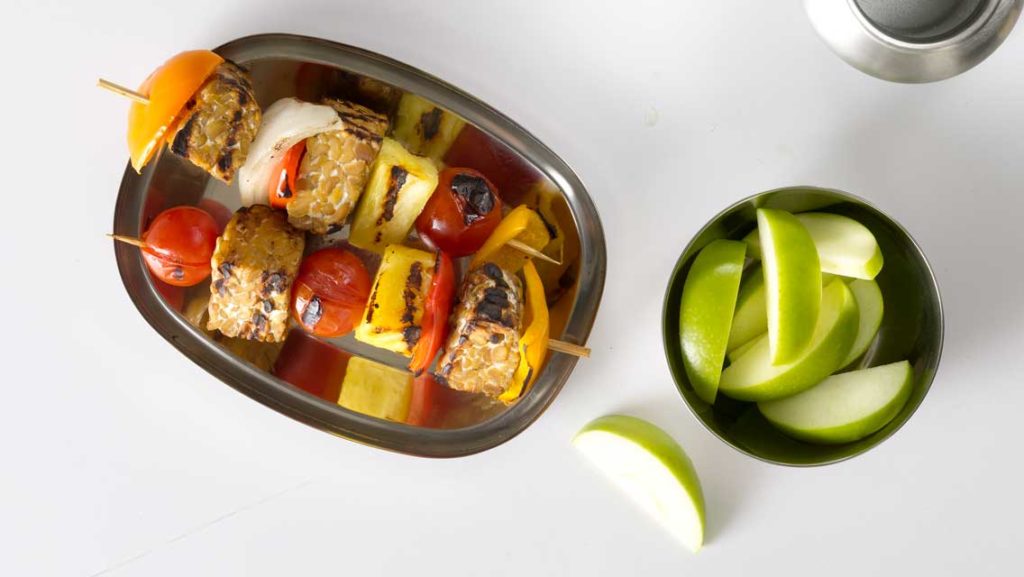
Kebabs:
Fun for kids to make and eat, these kebabs are full of protein and fiber, both of
which slow the conversion of carbs to glucose and balance the body’s glycemic load. Tempeh is also a fermented product that aids digestion. Swift suggests looking for organic tempeh — which does not contain genetically modified soy — and opting for grain-free versions. If your child is not a tempeh fan, try kebabs made from grassfed beef or free-range poultry instead.
Apples:
A great source of fiber and bioflavonoids, whole apples trump applesauce because they require chewing, which encourages children to enjoy the sensory pleasure of texture. Also, adds Swift, developing a preference for foods that must be chewed is a long-term strategy for maintaining a healthy weight.
Water:
Get your kids used to hydrating with water when they’re thirsty. Invest in a high-quality filter and a stainless-steel thermos. Drop a berry or a slice of cucumber or lime in for subtle flavor. Unsweetened herbal tea is also a good option. It’s best not to let children even get started on soda or other addictive sweetened drinks, says Swift.
Maggie Ward, MS, RDN, LDN
Chicken nuggets and tater tots — such cute names for such nutritional landmines! Even the basic ingredients in this cafeteria meal dismay Maggie Ward, MS, RDN, LDN, nutrition director at the UltraWellness Center in Lenox, Mass. “The meats in most school meals are from factory farms,” Ward says, “places where animals are not fed their natural diet and are usually given hormones and antibiotics.” She is equally leery of the tots: Conventional potatoes are high in pesticides. Instead of this highly processed fare, Ward creates a hot lunch you can pack or serve at home: chicken-vegetable soup, a salad of cukes and tomatoes, whole-seed crackers, and highly diluted juice.
BEFORE: Lunch #2

Chicken nuggets and tater tots:
These are processed foods at their worst, says Ward: “They’re usually battered and fried in fats high in refined omega-6 fats, which are inflammatory. And they’re often fried in oil that’s been used several times, which creates trans fats.” Ward also cautions all folks — but especially kids — to stay away from factory-farmed meat.
Green beans:
The industrial-canning process leaches vitamins, minerals, and phytonutrients from vegetables, Ward says. Additionally, most cans are still lined with BPA (bisphenol A), a chemical believed to be an endocrine disruptor that can affect brain development and behavior.
Milk:
Decades of aggressive ad campaigns by the dairy industry convinced U.S. consumers that milk is a nutrition staple. Yet many researchers have come to question the connection between drinking milk and good health. As long as your children don’t have milk allergies, drinking whole organic milk from grassfed cows is OK in moderation. But you don’t need to give your children milk to make sure they get enough calcium — they can get all they need from dark leafy greens, raw almonds, and other foods. (For more on milk, see “Do You Need Milk?”)
AFTER: Lunch #2

Soup:
Ward makes a simple-but-hearty soup every week, and it’s a cinch to send to school in a stainless-steel thermos. For her hot-lunch upgrade, she uses organic chicken with a selection of organic vegetables. Even children who don’t like greens will often enjoy them in soup. Ward adds rice pasta or some other gluten-free pasta to give the soup more substance. “I see so many people with gluten problems,” she says. “Even if your family doesn’t have problems with gluten intolerance, diversity is good and may prevent problems in the future.”
Salad:
Drizzle halved cherry tomatoes and small chunks of cucumber with extra-virgin olive oil and sprinkle with a pinch of sea salt. The healthy fats in the olive oil are critical for absorbing the nutrients in the veggies. They also help ward off hunger.
Crackers:
Who doesn’t love something to crunch on? Ward recommends packing some seed-based gluten-free crackers, such as Mary’s Gone Crackers.
Diluted juice:
Full-strength fruit juice packs a powerful sugar wallop. “Juice concentrates all the sugar from the fruit and eliminates most of the fiber,” Ward says. “Unless that sugar is balanced with protein or healthy fat, it can negatively affect children’s behavior and energy.” Instead, she suggests adding a splash of juice to filtered water — just enough to add some color and flavor.
Adriane Angarano, MS, CN
We asked Adriane Angarano, MS, CN, of Seattle’s Green Lake Nutrition, to suggest an alternative to a classic kid’s lunch — a peanut butter and jelly sandwich, a flavored-yogurt tube, Goldfish cheese crackers, and a juice box. Needless to say, she found plenty of room for improvement.
In place of this refined-carb-laden meal, she offers a Paleo-inspired feast: turkey-veggie meatballs with an herb-tomato dipping sauce, rosemary-toasted almonds, orange slices, and coconut-water kefir. “The old PB&J lunch plays to our sugar and salt addictions,” Angarano says. “The reimagined lunch is real, whole food.”
BEFORE: Lunch #3
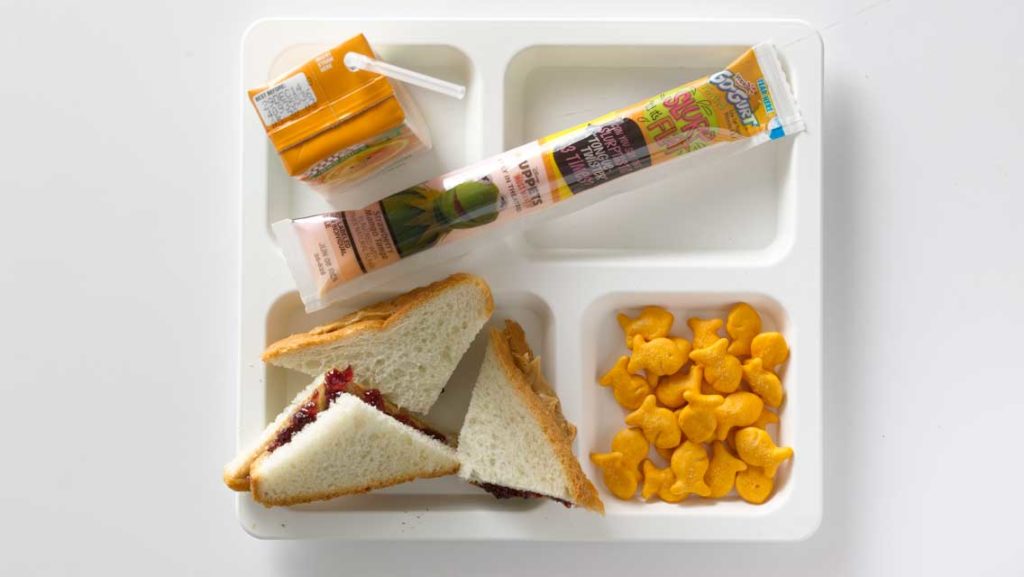
PB&J:
Most parents have moved on from white bread, but whole-wheat bread isn’t necessarily all that much better. Not only is it gluten-dense, it’s actually higher on the glycemic index than a Snickers bar. Add the sugar from the jelly, and you can expect a spike in blood sugar that will affect concentration and behavior for hours.
Flavored yogurt:
Most flavored-yogurt tubes are full of sugar and are either low-fat or nonfat, putting them surprisingly high on the glycemic index. Healthy fats and protein are essential because they prevent a blood-sugar crash,” says Angarano. (For more on the perils of low-fat dairy, see “Skimming the Truth“.)
Goldfish:
Angarano pulls no punches about this iconic kid snack: “Empty calories. White flour. No fiber. Tons of chemicals. Goldfish appease our liking for crunchy, cheesy, salty things, but provide no nutrition or energy.”
Juice box:
Packaged juices are basically liquid sugar, says Angarano, and they are often full of artificial colors, which have been shown to cause adverse, ADHD-like effects in children.
AFTER: Lunch #3
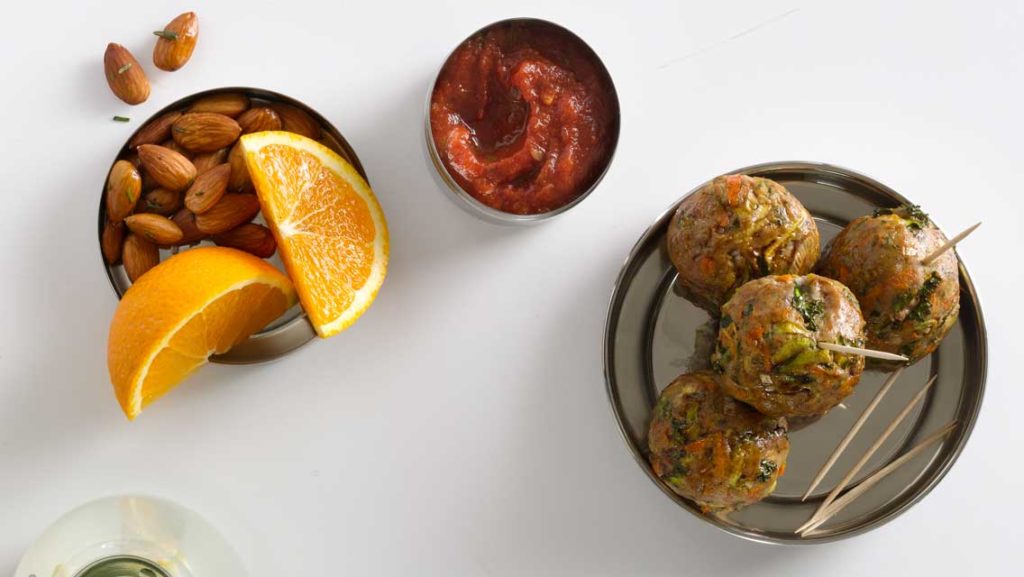
Meatballs and dipping sauce:
Angarano loads up these fun-size turkey meatballs with lots of finely chopped veggies. Her tomato dipping sauce contains fresh herbs, which punch up the antioxidant and flavor quotient. “The standard American diet is so bland!” she says. “It’s important to expose children to lots of flavors and textures at a young age.”
Orange slices:
Oranges are a wonderful source of fiber, vitamins, and phytonutrients. But mix it up, Angarano urges: “If we eat the same thing all the time, we’ll miss that variety of micronutrients.” Other lower-sugar fruits include berries of all types, apples, cherries, grapefruit, and pears.
Rosemary-toasted almonds:
Studies show that rosemary can enhance memory and focus, just one reason Angarano believes this herb is a great candidate for school lunchboxes. The almonds serve up healthy fats, fiber, and protein, all of which satisfy hunger and help moderate blood sugar.
Coconut-water kefir:
Although they are an acquired taste for some kids, kefir and other fermented drinks, such as kombucha, offer a delicious brew of probiotics and bioactive enzymes that enhance digestion and nutrient absorption. Angarano is especially fond of coconut-water kefir because it also has electrolytes and lauric acid, which fights the buildup of harmful yeasts and bacteria in our digestive systems.
Recipes
Kathie Swift’s Tempeh and Vegetable Skewers
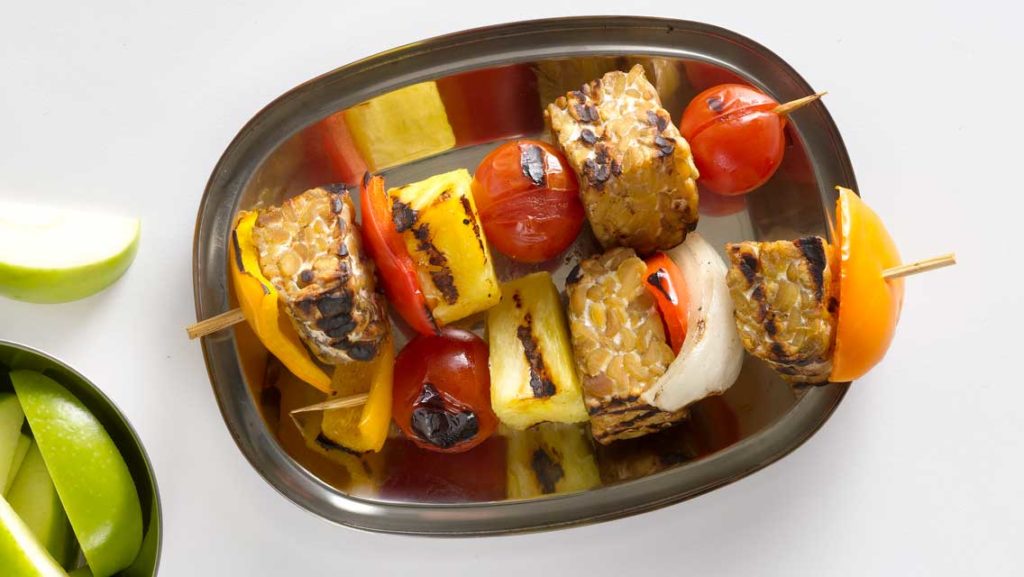
Makes four servings
- 1 red pepper, cut into 1-inch squares
- 1 yellow pepper, cut into 1-inch squares
- 1 orange pepper, cut into 1-inch squares
- 1 medium yellow onion, cut into wedges
- 16 cherry tomatoes
- 1 cup whole portabella mushrooms
- 1 cup pineapple, cut into 1-inch cubes
- 8 oz. organic gluten-free tempeh, cut into 1-inch squares
- 1/4 cup extra-virgin olive oil
- 1/4 cup lemon juice, freshly squeezed
- 1/2 teaspoon Chinese 5 spice
- Special equipment: Wooden or metal skewers
Directions
- In a large bowl, combine vegetables, pineapple, and tempeh.
- In a separate glass container, whisk together olive oil, lemon juice, and spice.
- Pour marinade over vegetables, stir to coat, and refrigerate one to two hours. Preheat grill to medium high.
- Alternate vegetables, pineapple, and tempeh on skewers and cook, turning onto all sides until done, approximately 10 minutes.
Maggie Ward’s Chicken Noodle Soup With Savoy Cabbage
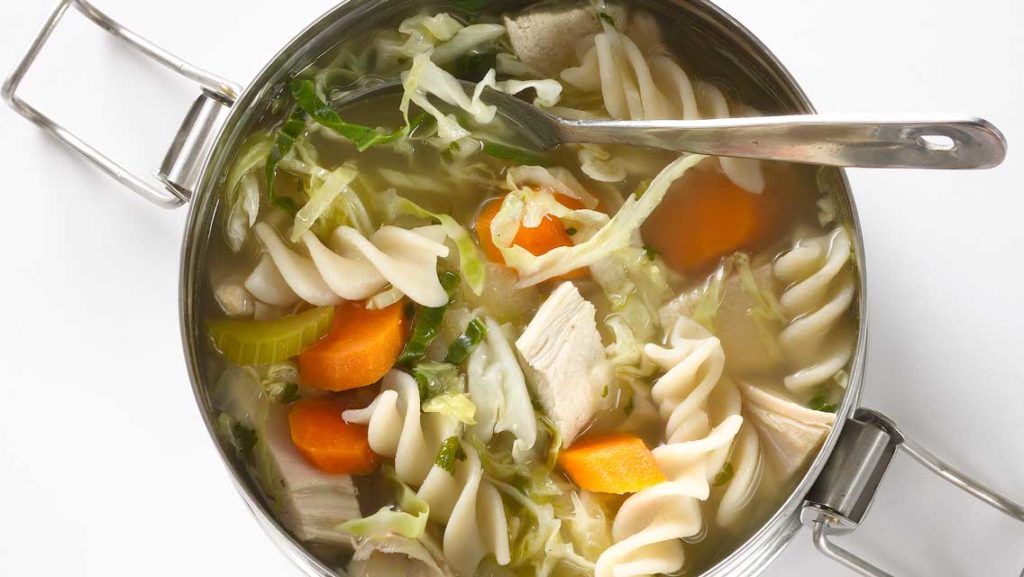
Makes four servings
- 2 to 3 tbs. extra-virgin olive oil
- 1 onion, chopped
- 2 carrots, chopped
- 2 ribs celery, chopped
- 3 tbs. chopped fresh parsley (or 1 tbs. dried)
- 2 quarts organic chicken stock
- 6 to 12 ounces spiral gluten-free pasta or cooked brown rice (optional)
- 1 rotisserie chicken, meat pulled from the bone
- 2 cups thinly sliced green cabbage
- 1– to 2 tbs. fresh lemon juice
- Salt and freshly ground black pepper to taste
Directions
- In a large stock pot, add oil and sauté the onion until caramelized.
- Add in the carrots, celery, and parsley, and sauté until the vegetables are soft.
- Add the broth and bring to a boil.
- Add the pasta (if using), and boil until three-quarters done.
- Add the chicken and cabbage, and cook until the cabbage is softened. Add lemon juice, salt, and pepper to taste.
Adriane Angarano’s Turkey and Veggie Meatballs
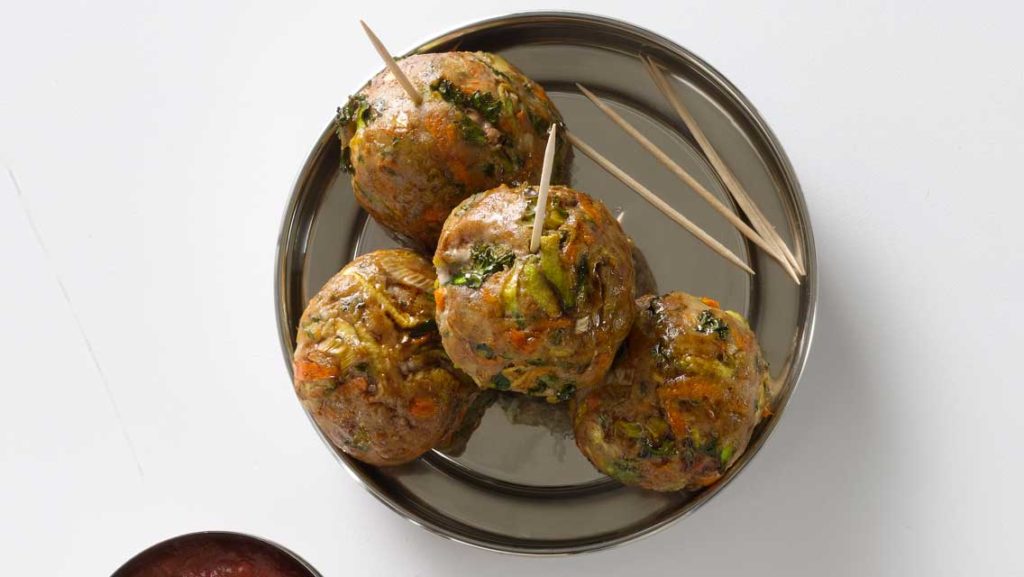
Makes four servings
- 1 lb. ground turkey breast
- 1 small zucchini, grated
- 1 medium carrot, grated
- 1/4 cup finely chopped kale
- 1 tbs. finely chopped fresh parsley
- 1 tbs. minced scallions
- 1 tbs. extra-virgin olive oil
- 1 tsp. poultry seasoning
- 1/2 tsp. granulated garlic powder
- 1/2 tsp. sea salt
- 2 tbs. grape-seed oil
Directions
- Preheat oven to 375 degrees F. Line a baking sheet with parchment paper.
- In a mixing bowl, combine all ingredients thoroughly with your hands.
- Form into 12 meatballs, and place on baking sheet.
- Roast for about 20 to 25 minutes until cooked through and the internal temperature reaches 165 degrees F. Serve with tomato dipping sauce (recipe below).
Herby Tomato Sauce
- 2 tbs. extra-virgin olive oil
- 1/2 cup chopped onion
- 4 garlic cloves, minced
- 3 tbs. chopped fresh oregano (or 1 tbs. dried oregano)
- 3 tbs. chopped fresh basil (or 2 tsp. dried basil)
- 1/2 tsp. thyme
- 1/2 tsp. salt
- 1/4 tsp. freshly ground black pepper
- 15 oz. can organic tomato sauce
- 6 oz. can organic tomato paste
- 2 tsp. honey
Directions
- Heat oil in a skillet over medium-low heat. Add the onions and sauté for 10 minutes, stirring occasionally.
- Stir in the garlic, oregano, basil, thyme, salt, and pepper, and sauté for one minute.
- Add the remaining ingredients, and cook for 10 to 15 minutes over medium-low heat, stirring occasionally.
This article originally appeared as “Thinking Outside the Lunchbox” in the September 2014 issue of Experience Life.
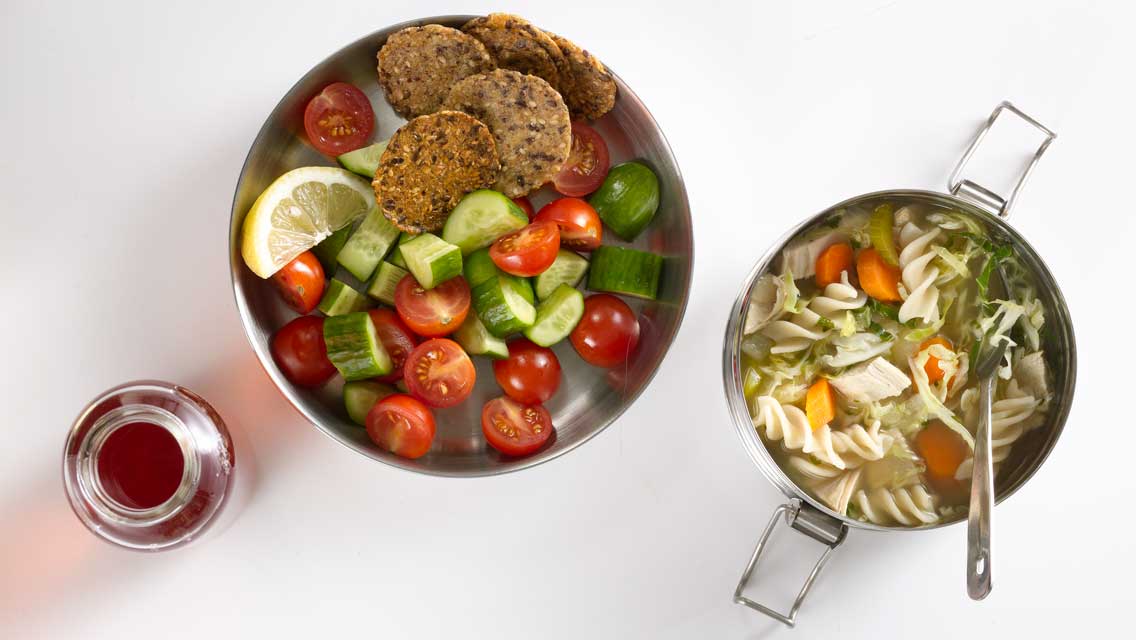
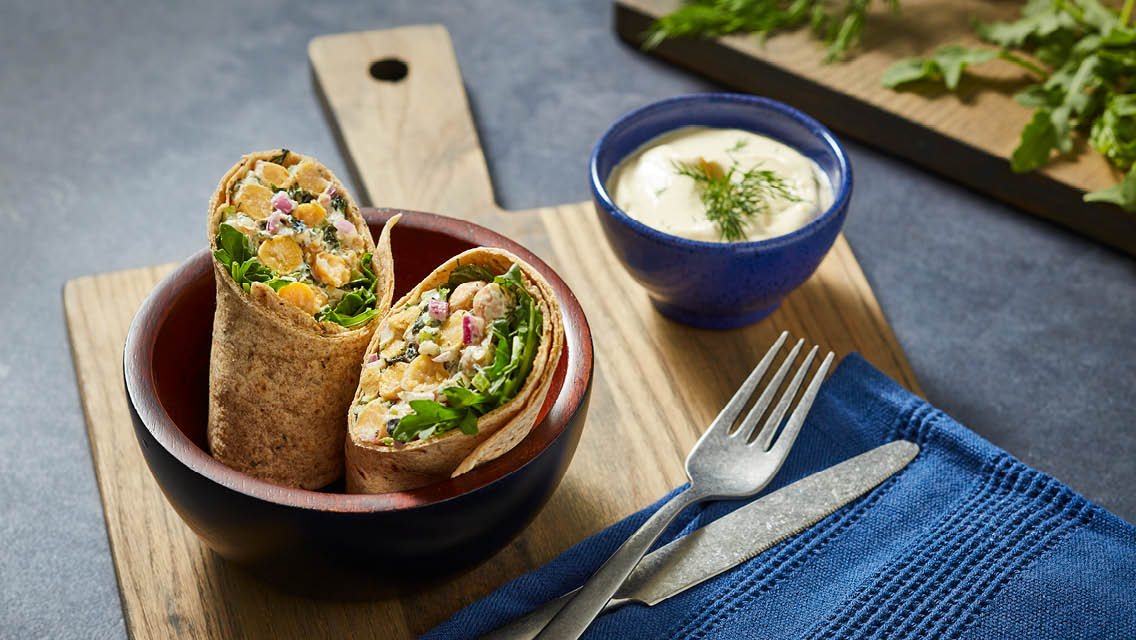
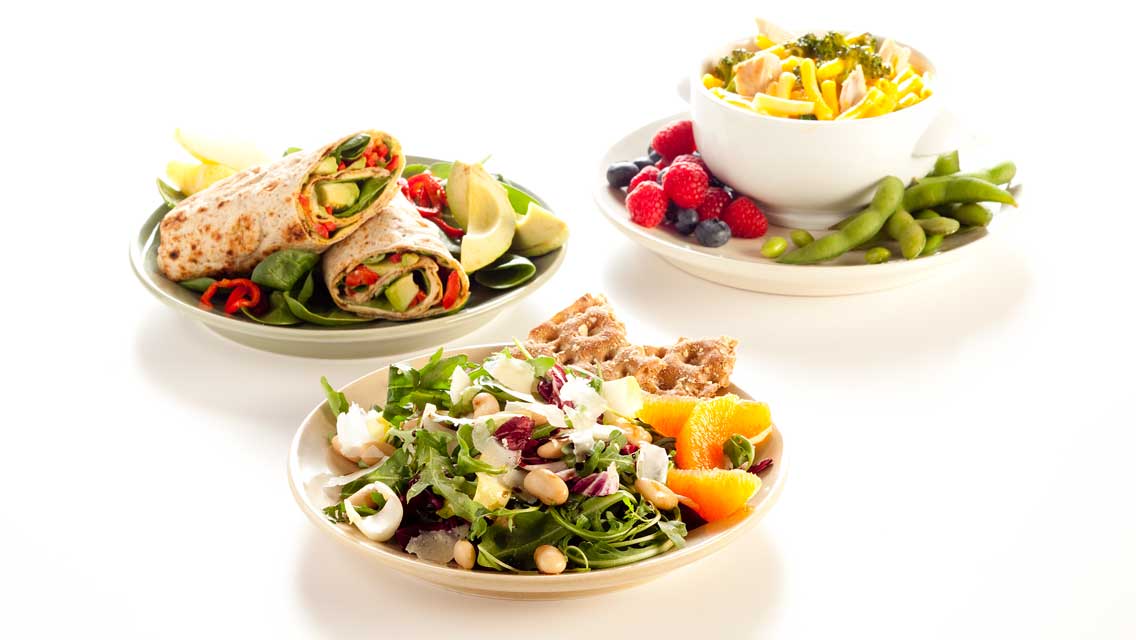
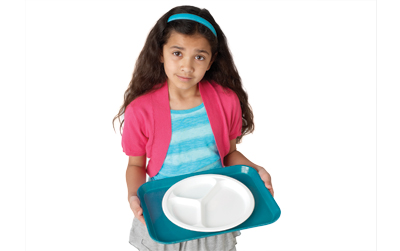
This Post Has 0 Comments